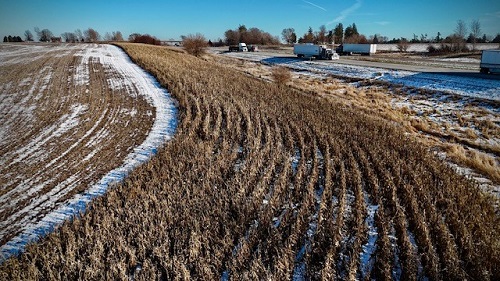With winter fast approaching, the Iowa Department of Transportation is touting the value of its “Standing Corn Snow Fence” program that plays a crucial role in keeping snow off roadways, especially in rural parts of the state.
[Above photo by the Iowa DOT]
Around since the 1980s, this program teams Iowa DOT up with farmers whose fields are along highways in open, flat areas. Farmers leave corn standing in their fields over the winter, with those rows of corn acting as natural snow fences – helping slow down or even stop snow from drifting across the roads.

Farmers can also create round bales from that standing corn to build similar natural snow fences, the agency said.
In return for their help, Iowa DOT pays farmers $5.65 per bushel for leaving anywhere from six to 24 rows of corn standing – a price typically about $2 more than the statewide average price of corn as of August 1 this year.
For round bales, the agency pays $1 per linear foot, with landowners agreeing to leave the bales in place throughout the winter.
[Editor’s note: State departments of transportation across the country use different kinds of plant life and low-tech materials to build different types of snow fences, as the video below from the Wyoming Department of Transportation details.]
“Studies show that plowing snow costs 100 times more than trapping it with a snow fence, so these partnerships really pay off,” noted Craig Bargfrede, who oversees Iowa DOT’s winter operations, in a blog post.
While the program is mutually beneficial by saving the Iowa DOT money in plowing costs and providing farmers compensation for their participation, the program goes well beyond the financial benefits, the agency stressed, such as providing habitat for wildlife; increasing soil moisture in the end rows; and helping control soil erosion.
By working together Iowa DOT staff and local landowners build strong partnerships so they can jointly identify the best spots for standing corn or round bales to help keep travelers safer in the winter months.
That is because landowners are familiar with how snow moves across their land, while the Iowa DOT is familiar with areas of road that suffer from blowing and drifting problem, the agency said – noting that the department also works with farmers to install permanent or temporary snow fences made from trees, bushes, or other plants in some areas.
 States
States
Georgia DOT Foreman Receives Two Heroism Awards
January 2, 2026 States
States

